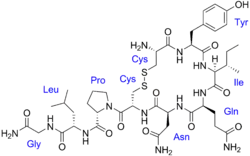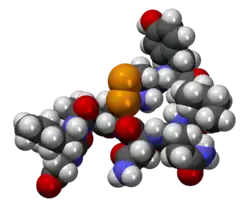 | |
 | |
| Clinical data | |
|---|---|
| Pronunciation | /ˌɒksɪˈtoʊsɪn/ |
| Trade names | Pitocin, Syntocinon, Viatocinon, others |
| AHFS/Drugs.com | Monograph |
| Pregnancy category |
|
| Routes of administration | Intranasal, IV, IM |
| ATC code | |
| Legal status | |
| Legal status |
|
| Pharmacokinetic data | |
| Protein binding | 30% |
| Metabolism | Liver and elsewhere (via oxytocinases) |
| Elimination half-life | 1–6 min (IV) ~2 h (intranasal)[1][2] |
| Excretion | Biliary and kidney |
| Identifiers | |
| |
| CAS Number | |
| PubChem CID | |
| IUPHAR/BPS | |
| DrugBank | |
| ChemSpider | |
| UNII | |
| KEGG | |
| ChEBI | |
| ChEMBL | |
| Chemical and physical data | |
| Formula | C43H66N12O12S2 |
| Molar mass | 1007.19 g·mol−1 |
| 3D model (JSmol) | |
| |
| |
| (verify) | |
Synthetic oxytocin, sold under the brand name Pitocin among others, is a medication made from the peptide oxytocin.[3][4] As a medication, it is used to cause contraction of the uterus to start labor, increase the speed of labor, and to stop bleeding following delivery.[3] For this purpose, it is given by injection either into a muscle or into a vein.[3]
Oxytocin is also available in intranasal spray form for psychiatric, endocrine and weight management use as a supplement. Intranasal oxytocin works on a different pathway than injected oxytocin, primarily along the olfactory nerve crossing the brain blood barrier to the olfactory lobe in the brain, where dense magnocellular oxytocin neurons receive the dose application.
The use of synthetic oxytocin as an injectable medication for inducing childbirth can result in excessive contraction of the uterus that can risk the health of the baby.[3] Common side effects in the mother include nausea and a slow heart rate.[3] Serious side effects include rupture of the uterus and with excessive dose, water intoxication.[3] Allergic reactions including anaphylaxis may also occur.[3]
The natural occurrence of oxytocin was discovered in 1906.[5][6] It is on the World Health Organization's List of Essential Medicines.[7]
Medical uses
An intravenous infusion of oxytocin is used to induce labor and to support labor in case of slow childbirth if the oxytocin challenge test fails. Whether a high dose is better than a standard dose for labor induction is unclear. It has largely replaced ergometrine as the principal agent to increase uterine tone in acute postpartum hemorrhage. Oxytocin is also used in veterinary medicine to facilitate birth and to stimulate milk release.
The tocolytic agent atosiban (Tractocile) acts as an antagonist of oxytocin receptors. It is registered in many countries for use in suppressing premature labor between 24 and 33 weeks of gestation. It has fewer side effects than drugs previously used for this purpose (such as ritodrine, salbutamol and terbutaline).[8]
Oxytocin has not been found to be useful for improving breastfeeding success.[9]
Contraindications
Oxytocin injection (synthetic) is contraindicated in any of these conditions:[10]
- Substantial cephalopelvic disproportion
- Unfavorable fetal position or presentation (e.g., transverse lies) undeliverable without conversion before delivery
- Obstetric emergencies where maternal or fetal risk-to-benefit ratio favors surgery
- Fetal distress when delivery is not imminent
- Umbilical cord prolapse
- Uterine activity fails to progress adequately
- Hyperactive or hypertonic uterus
- Vaginal delivery is contraindicated (e.g., invasive cervical carcinoma, active genital herpes infection, total placenta previa, vasa previa, cord presentation or prolapse)
- Uterine or cervical scarring from previous cesarean section or major cervical or uterine (e.g., transfundal) surgery
- Unengaged fetal head
- History of hypersensitivity to oxytocin or any ingredient in the formulation
Side effects
Oxytocin is relatively safe when used at recommended doses, and side effects are uncommon.[11] These maternal events have been reported:[11]
- Subarachnoid hemorrhage
- Increased blood pressure
- Cardiac arrhythmia including increased or decreased heart rate, and premature ventricular contraction
- Impaired uterine blood flow
- Pelvic hematoma
- Afibrinogenemia
- Anaphylaxis[3]
- Nausea and vomiting
- Increase fetal blood flow
Excessive dosage or long-term administration (over a period of 24 hours or longer) has been known to result in tetanic uterine contractions, uterine rupture, postpartum hemorrhage, and water intoxication, sometimes fatal.
Oxytocin was added to the Institute for Safe Medication Practices's list of High Alert Medications in Acute Care Settings in 2012.[12] The list includes medications that have a high risk for harm if administered incorrectly.[12]
During pregnancy, increased uterine motility has led to decreased heart rate, cardiac arrhythmia, seizures, brain damage, and death in the fetus or neonate.[11]
Use is linked to an increased risk of postpartum depression in the mother.[13]
Certain learning and memory functions are impaired by centrally administered oxytocin.[14] Also, systemic oxytocin administration can impair memory retrieval in certain aversive memory tasks.[15] However, oxytocin does seem to facilitate learning and memory specifically for social information. Healthy males administered intranasal oxytocin show improved memory for human faces, in particular happy faces.[16][17]
Pharmacokinetics
Routes of administration

One IU of oxytocin is the equivalent of about 2 μg or mcg of pure peptide.
- Injection: Clinical doses of oxytocin are given by injection either into a muscle or into a vein to cause contraction of the uterus.[3] Very small amounts (< 1%) do appear to enter the central nervous system in humans when peripherally administered.[18] The compound has a half-life of typically about 3 minutes in the blood when given intravenously. Intravenous administration requires 40 minutes to reach a steady-state concentration and achieve maximum uterine contraction response.[19]
- Buccal: Oxytocin was delivered in buccal tablets, but this is not common practice any more.[20]
- Under the tongue: Oxytocin is poorly absorbed sublingually.[21]
- Nasal administration: Oxytocin is effectively distributed to the brain when administered intranasally via a nasal spray, after which it reliably crosses the blood–brain barrier and exhibits psychoactive effects in humans.[22][23] No serious adverse effects with short-term application of oxytocin with 18~40 IU (36–80 mcg) have been recorded.[24] Intranasal oxytocin has a central duration of at least 2.25 hours and as long as 4 hours.[1][2]
- Oral: While it was originally assumed that Oxytocin administered orally would be destroyed in the gastrointestinal tract, studies have shown that Oxytocin is transported by the immunoglobulin RAGE (receptor for advanced glycation end products) across the intestinal epithelium and into the blood. Orally-administered Oxytocin has been shown to increase putamen responses to facial emotions in humans.[25] Oxytocin administered orally produces different effects on human behaviour and brain function than when given intranasally, possibly due to variations in the molecular transport and binding mechanisms.
Chemistry
Peptide analogues of oxytocin with similar actions, for example carbetocin (Duratocin) and demoxytocin (Sandopart), have been developed and marketed for medical use.[26] In addition, small-molecule oxytocin receptor agonists, like TC OT 39, WAY-267464, and LIT-001 have been developed and studied.[26] However, lack of selectivity over vasopressin receptors has so far limited the potential usefulness of small-molecule oxytocin receptor agonists.[26]
History
Oxytocin's uterine-contracting properties were discovered by British pharmacologist Henry Hallett Dale in 1906.[6] Oxytocin's milk ejection property was described by Ott and Scott in 1910[27] and by Schafer and Mackenzie in 1911.[28]
Oxytocin was the first polypeptide hormone to be sequenced[29] or synthesized.[30][31] Du Vigneaud was awarded the Nobel Prize in 1955 for his work.[32]
Etymology
The word oxytocin was coined from the term oxytocic. Greek ὀξύς, oxys, and τόκος, tokos, meaning "quick birth".
Society and culture
Counterfeits
In African countries, some oxytocin products were found to be counterfeit medications.[33][34]
Other uses
The trust-inducing property of oxytocin might help those with social anxiety and depression,[35] anxiety, fear, and social dysfunctions, such as generalized anxiety disorder, post-traumatic stress disorder, and social anxiety disorder, as well as autism and schizophrenia, among others.[36][37] However, in one meta-analysis only autism spectrum disorder showed a significant combined effect size.[38]
People using oxytocin show improved recognition for positive social cues over threatening social cues[39][40] and improved recognition of fear.[41]
- Autism: Oxytocin may play a role in autism and may be an effective treatment for autism's repetitive and affiliative behaviors.[42]
- Relationship counseling: The use of oxytocin in relationship counseling for well-being has been suggested.[43]
See also
References
- 1 2 Weisman O, Zagoory-Sharon O, Feldman R (September 2012). "Intranasal oxytocin administration is reflected in human saliva". Psychoneuroendocrinology. 37 (9): 1582–86. doi:10.1016/j.psyneuen.2012.02.014. PMID 22436536. S2CID 25253083.
- 1 2 Huffmeijer R, Alink LR, Tops M, Grewen KM, Light KC, Bakermans-Kranenburg MJ, Ijzendoorn MH (2012). "Salivary levels of oxytocin remain elevated for more than two hours after intranasal oxytocin administration". Neuro Endocrinology Letters. 33 (1): 21–25. PMID 22467107.
- 1 2 3 4 5 6 7 8 9 "Oxytocin". The American Society of Health-System Pharmacists. Archived from the original on 20 May 2015. Retrieved 1 June 2015.
- ↑ The Oxford Handbook of Prosocial Behavior. Oxford University Press. 2015. p. 354. ISBN 978-0-19-539981-3. Archived from the original on 2017-08-01.
- ↑ Hurlemann R, Grinevich V (2018). Behavioral Pharmacology of Neuropeptides: Oxytocin. Springer. p. 37. ISBN 978-3319637396.
- 1 2 Dale HH (May 1906). "On some physiological actions of ergot". The Journal of Physiology. 34 (3): 163–206. doi:10.1113/jphysiol.1906.sp001148. PMC 1465771. PMID 16992821.
- ↑ World Health Organization (2019). World Health Organization model list of essential medicines: 21st list 2019. Geneva: World Health Organization. hdl:10665/325771. WHO/MVP/EMP/IAU/2019.06. License: CC BY-NC-SA 3.0 IGO.
- ↑ Budden A, Chen LJ, Henry A (Oct 9, 2014). "High-dose versus low-dose oxytocin infusion regimens for induction of labour at term". The Cochrane Database of Systematic Reviews. 10 (10): CD009701. doi:10.1002/14651858.CD009701.pub2. PMC 8932234. PMID 25300173.
- ↑ "Oxytocin use while Breastfeeding". Drugs.com. Archived from the original on 2016-12-15.
- ↑ "Oxytocin - FDA prescribing information, side effects and uses". Archived from the original on 2016-12-21. Retrieved 2016-12-16.
- 1 2 3 "Pitocin (drug label for professionals)". Rx List. WebMD. Archived from the original on 2011-04-15. Retrieved 2010-09-09.
- 1 2 "High-Alert Medications in Acute Care Settings". Institute For Safe Medication Practices. 16 November 2017. Retrieved 2019-05-06.
- ↑ Kroll-Desrosiers AR, Nephew BC, Babb JA, Guilarte-Walker Y, Moore Simas TA, Deligiannidis KM (February 2017). "Association of peripartum synthetic oxytocin administration and depressive and anxiety disorders within the first postpartum year". Depression and Anxiety. 34 (2): 137–146. doi:10.1002/da.22599. PMC 5310833. PMID 28133901.
- ↑ Gimpl G, Fahrenholz F (April 2001). "The oxytocin receptor system: structure, function, and regulation". Physiological Reviews. 81 (2): 629–83. doi:10.1152/physrev.2001.81.2.629. PMID 11274341. S2CID 13265083.
- ↑ de Oliveira LF, Camboim C, Diehl F, Consiglio AR, Quillfeldt JA (January 2007). "Glucocorticoid-mediated effects of systemic oxytocin upon memory retrieval". Neurobiology of Learning and Memory. 87 (1): 67–71. doi:10.1016/j.nlm.2006.05.006. PMID 16997585. S2CID 25371427.
- ↑ Guastella AJ, Mitchell PB, Mathews F (August 2008). "Oxytocin enhances the encoding of positive social memories in humans". Biological Psychiatry. 64 (3): 256–58. doi:10.1016/j.biopsych.2008.02.008. PMID 18343353. S2CID 38681820.
- ↑ Rimmele U, Hediger K, Heinrichs M, Klaver P (2009). "Oxytocin Makes a Face in Memory Familiar". The Journal of Neuroscience. 29 (1): 38–42. doi:10.1523/JNEUROSCI.4260-08.2009. PMC 6664913. PMID 19129382.
- ↑ Baribeau DA, Anagnostou E (2015). "Oxytocin and vasopressin: linking pituitary neuropeptides and their receptors to social neurocircuits". Frontiers in Neuroscience. 9: 335. doi:10.3389/fnins.2015.00335. PMC 4585313. PMID 26441508.
- ↑ Seitchik J, Castillo M (December 1982). "Oxytocin augmentation of dysfunctional labor. I. Clinical data". American Journal of Obstetrics and Gynecology. 144 (8): 899–905. doi:10.1097/00006254-198307000-00010. PMID 7148921.
- ↑ Mehta AC (1986). "Buccal and oral drugs: induction of labour". Acta Chirurgica Hungarica. 27 (3): 157–63. PMID 3469841.
- ↑ De Groot AN, Vree TB, Hekster YA, Pesman GJ, Sweep FC, Van Dongen PJ, Van Roosmalen J (1995). "Bioavailability and pharmacokinetics of sublingual oxytocin in male volunteers" (PDF). The Journal of Pharmacy and Pharmacology. 47 (7): 571–75. doi:10.1111/j.2042-7158.1995.tb06716.x. hdl:2066/21581. PMID 8568623. S2CID 8615529.
- ↑ Malenka RC, Nestler EJ, Hyman SE (2009). "Chapter 7: Neuropeptides". In Sydor A, Brown RY (eds.). Molecular Neuropharmacology: A Foundation for Clinical Neuroscience (2nd ed.). New York: McGraw-Hill Medical. ISBN 978-0-07-148127-4.
Oxytocin can be delivered to humans via nasal spray following which it crosses the blood–brain barrier. ... In a double-blind experiment, oxytocin spray increased trusting behavior compared to a placebo spray in a monetary game with real money at stake.
- ↑ McGregor IS, Callaghan PD, Hunt GE (May 2008). "From ultrasocial to antisocial: a role for oxytocin in the acute reinforcing effects and long-term adverse consequences of drug use?". British Journal of Pharmacology. 154 (2): 358–68. doi:10.1038/bjp.2008.132. PMC 2442436. PMID 18475254.
Recent studies also highlight remarkable anxiolytic and prosocial effects of intranasally administered OT in humans, including increased 'trust', decreased amygdala activation towards fear-inducing stimuli, improved recognition of social cues and increased gaze directed towards the eye regions of others (Kirsch et al., 2005; Kosfeld et al., 2005; Domes et al., 2006; Guastella et al., 2008).
- ↑ Lee SY, Lee AR, Hwangbo R, Han J, Hong M, Bahn GH (2015). "Is Oxytocin Application for Autism Spectrum Disorder Evidence-Based?". Experimental Neurobiology. 24 (4): 312–24. doi:10.5607/en.2015.24.4.312. PMC 4688331. PMID 26713079.
- ↑ Kou J, Lan C, Zhang Y, Wang Q, Zhou F, Zhao Z, et al. (February 2021). "In the nose or on the tongue? Contrasting motivational effects of oral and intranasal oxytocin on arousal and reward during social processing". Translational Psychiatry. 11 (1): 94. doi:10.1038/s41398-021-01241-w. PMC 7862637. PMID 33542175.
- 1 2 3 Nashar PE, Whitfield AA, Mikusek J, Reekie TA (2022). "The Current Status of Drug Discovery for the Oxytocin Receptor". Oxytocin. Methods Mol Biol. Vol. 2384. pp. 153–174. doi:10.1007/978-1-0716-1759-5_10. ISBN 978-1-0716-1758-8. PMID 34550574. S2CID 239090096.
- ↑ Ott I, Scott JC (1910). "The Action of Infundibulum upon Mammary Secretion". Proceedings of the Society for Experimental Biology and Medicine. 8: 48–49. doi:10.3181/00379727-8-27. S2CID 87519246.
{{cite journal}}: CS1 maint: overridden setting (link) - ↑ Schafer EA, Mackenzie K (July 1911). "The Action of Animal Extracts on Milk Secretion". Proceedings of the Royal Society B. 84 (568): 16–22. Bibcode:1911RSPSB..84...16S. doi:10.1098/rspb.1911.0042. S2CID 93718970.
- ↑ Du Vigneaud V, Ressler C, Trippett S (December 1953). "The sequence of amino acids in oxytocin, with a proposal for the structure of oxytocin". The Journal of Biological Chemistry. 205 (2): 949–57. doi:10.1016/S0021-9258(18)49238-1. PMID 13129273.
- ↑ du Vigneaud V, Ressler C, Swan JM, Roberts CW, Katsoyannis PG, Gordon S (1953). "The synthesis of an octapeptide amide with the hormonal activity of oxytocin". J. Am. Chem. Soc. 75 (19): 4879–80. doi:10.1021/ja01115a553.
- ↑ du Vigneaud V, Ressler C, Swan JM, Roberts CW, Katsoyannis PG (June 1954). "The synthesis of oxytocin". J. Am. Chem. Soc. 76 (12): 3115–21. doi:10.1021/ja01641a004.
- ↑ Du Vigneaud V (June 1956). "Trail of sulfur research: from insulin to oxytocin". Science. 123 (3205): 967–74. Bibcode:1956Sci...123..967D. doi:10.1126/science.123.3205.967. PMID 13324123.
- ↑ Torloni MR, Gomes Freitas C, Kartoglu UH, Metin Gülmezoglu A, Widmer M (December 2016). "Quality of oxytocin available in low- and middle-income countries: a systematic review of the literature". BJOG: An International Journal of Obstetrics and Gynaecology. 123 (13): 2076–86. doi:10.1111/1471-0528.13998. PMID 27006180.
- ↑ Stanton C, Koski A, Cofie P, Mirzabagi E, Grady BL, Brooke S (2012). "Uterotonic drug quality: an assessment of the potency of injectable uterotonic drugs purchased by simulated clients in three districts in Ghana". BMJ Open. 2 (3): e000431. doi:10.1136/bmjopen-2011-000431. PMC 3346944. PMID 22556159.
- ↑ Hurlemann R, Patin A, Onur OA, Cohen MX, Baumgartner T, Metzler S, Dziobek I, Gallinat J, Wagner M, Maier W, Kendrick KM (April 2010). "Oxytocin enhances amygdala-dependent, socially reinforced learning and emotional empathy in humans". The Journal of Neuroscience. 30 (14): 4999–5007. doi:10.1523/JNEUROSCI.5538-09.2010. PMC 6632777. PMID 20371820.
- ↑ Cochran DM, Fallon D, Hill M, Frazier JA (2013). "The role of oxytocin in psychiatric disorders: a review of biological and therapeutic research findings". Harvard Review of Psychiatry. 21 (5): 219–47. doi:10.1097/HRP.0b013e3182a75b7d. PMC 4120070. PMID 24651556.
- ↑ Neumann ID, Slattery DA (2016). "Oxytocin in General Anxiety and Social Fear: A Translational Approach". Biological Psychiatry. 79 (3): 213–21. doi:10.1016/j.biopsych.2015.06.004. PMID 26208744.
- ↑ Bakermans-Kranenburg MJ, van I Jzendoorn MH (2013). "Sniffing around oxytocin: review and meta-analyses of trials in healthy and clinical groups with implications for pharmacotherapy". Translational Psychiatry. 3 (5): e258. doi:10.1038/tp.2013.34. PMC 3669921. PMID 23695233.
- ↑ Unkelbach C, Guastella AJ, Forgas JP (November 2008). "Oxytocin selectively facilitates recognition of positive sex and relationship words". Psychological Science. 19 (11): 1092–94. doi:10.1111/j.1467-9280.2008.02206.x. PMID 19076479. S2CID 19670817.
- ↑ Marsh AA, Yu HH, Pine DS, Blair RJ (April 2010). "Oxytocin improves specific recognition of positive facial expressions". Psychopharmacology. 209 (3): 225–32. doi:10.1007/s00213-010-1780-4. PMID 20186397. S2CID 4820244.
- ↑ Fischer-Shofty M, Shamay-Tsoory SG, Harari H, Levkovitz Y (2010). "The effect of intranasal administration of oxytocin on fear recognition". Neuropsychologia. 48 (1): 179–84. doi:10.1016/j.neuropsychologia.2009.09.003. PMID 19747930. S2CID 34778485.
- ↑ Bartz JA, Hollander E (2008). "Oxytocin and experimental therapeutics in autism spectrum disorders". Advances in Vasopressin and Oxytocin – from Genes to Behaviour to Disease. Progress in Brain Research. Vol. 170. pp. 451–62. doi:10.1016/S0079-6123(08)00435-4. ISBN 978-0-444-53201-5. PMID 18655901.
- ↑ Wudarczyk OA, Earp BD, Guastella A, Savulescu J (2013). "Could intranasal oxytocin be used to enhance relationships? Research imperatives, clinical policy, and ethical considerations". Current Opinion in Psychiatry. 26 (5): 474–84. doi:10.1097/YCO.0b013e3283642e10. PMC 3935449. PMID 23880593.